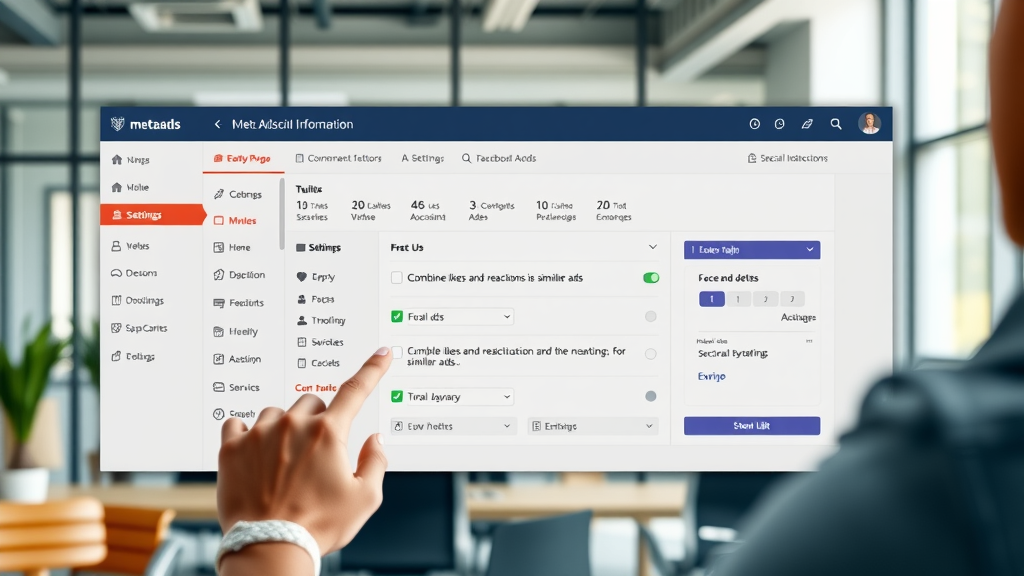Have you ever wondered why some small businesses waste money on Facebook ads while others unlock game-changing growth? In today’s digital-first world, knowing how to run Facebook ads for small businesses isn’t just a bonus—it’s essential for survival and success. This guide will demystify the steps, reveal smart strategies, and show you how to avoid those rookie mistakes that waste your precious budget. Are You Wasting Money When You Run Facebook Ads for Small Businesses? Are your Facebook ads driving the results your small business deserves? Discover why many business owners misunderstand the true cost and value of running Facebook ads. Challenge common advertising myths and unveil the realities of effective Facebook advertising. Unlocking Success: What You'll Learn About How to Run Facebook Ads for Small Businesses Proven strategies for running Facebook ad campaigns that deliver value for small businesses. How to use Facebook Ads Manager efficiently and creatively. Targeting options and ad set configurations tailored for small businesses. Measuring and maximizing every dollar spent on Facebook ad campaigns. The Essentials: Why Run Facebook Ads for Small Businesses? When you run Facebook ads for small businesses, you tap into one of the most powerful social media platforms available today. Whether you’re an established business owner or just starting, Facebook advertising puts your brand in front of millions of potential customers affordably. The platform enables you to target specific demographics, curate messaging that reflects your brand’s personality, and track results in real time—all key aspects for any advertising campaign hoping to move the needle. With careful planning, even a small business working with limited budgets can achieve impressive results and outshine larger competitors. Unlike other paid ad options, such as Google Ads, running Facebook ads offers scalability, unparalleled audience targeting, and the ability to generate high-quality leads for minimal spend. You’ll increase brand awareness, grow your customer base, and boost sales by reaching people where they already spend their time—on social media. Plus, the Facebook ads manager provides all the tools necessary for campaign setup, testing, and continuous improvement. Driving Growth with Facebook Advertising A thoughtful Facebook ad strategy can accelerate your small business’ growth trajectory. By running Facebook ads, you can direct traffic to your website, generate qualified leads for your sales funnel, or increase walk-in visits to your local storefront. Smart use of the ads manager allows you to create multiple ad sets, each with its own creative and targeting options, ensuring your advertising campaign dynamically responds to audience behavior. Leveraging the Facebook Pixel amplifies your ability to measure results and retarget users who have shown interest, further improving your conversion rate and reducing cost per click. Building Brand Awareness With Facebook Ads For many small businesses, brand awareness is the crucial first step to long-term success. Facebook advertising uniquely enables you to broadcast your story and values to audiences that matter most. By establishing a consistent visual identity and core message in each paid ad, you increase recognition among potential customers and inspire trust. With the platform’s precision targeting, your ad campaigns reach real people likely to become fans and followers—not just random users scrolling by. Reach millions: Facebook page access to diverse demographics Precision targeting: focus your ad set for the right audience Scalable budgets: control spending as you grow your small business Establishing a Strong Foundation: Setting Up Your Facebook Page and Ads Manager Creating a Business Page for Effective Facebook Advertising Before you run Facebook ads for small businesses, you’ll need an optimized Facebook business page. This serves as the digital home base for your brand, letting current and future customers discover more about your offerings and engage with your content. An active, well-branded business page improves the credibility of every ad campaign you launch, offering a platform where reviews, testimonials, and organic posts reinforce your paid advertising. Getting Started With Facebook Ads Manager The Facebook Ads Manager is your mission control for running Facebook ads. Here, you create, manage, and monitor every ad set and campaign. It’s important to familiarize yourself with the features, such as audience targeting, budgeting, creative formats, and reporting tools. An organized ads manager dashboard can mean the difference between a confusing experience and a well-oiled system that consistently delivers results. Take time to experiment with its interface—you’ll want to be comfortable navigating and tweaking campaigns as your business grows. A robust facebook page and a well-organized facebook ads manager are the backbone of running successful facebook ads for small businesses. Defining Objectives: Setting Your Facebook Ad Campaign Goals Selecting the Right Facebook Ad Campaign Type Choosing the right Facebook ad campaign type is crucial for achieving your desired results. Facebook offers campaign types for nearly every objective—whether you want to increase brand awareness, drive website traffic, collect leads, or boost conversions. Be clear about your primary business goal before launching any ad set. If you’re just starting, “Brand Awareness” or “Reach” objectives work well for introducing your small business to a larger audience. For those ready to sell products or services, “Conversions” or “Sales” campaigns can maximize ROI with the right targeting. Clarifying Brand Awareness vs. Conversion Objectives When defining your Facebook ad campaign's goal, it's important to know the difference between brand awareness and conversion-focused objectives. Brand awareness targets getting your small business noticed within your community. Conversion objectives, on the other hand, focus on getting users to take specific actions like purchasing or signing up. Your campaign’s structure—including ad set targeting options and creative assets—should reflect these objectives for best results. Brand Awareness Lead Generation Website Traffic Sales and Conversions Mastering Your Audience: Targeting Options for Small Businesses When You Run Facebook Ads Understanding Target Audience and Custom Audiences The real superpower of running Facebook ads is the ability to finely target the audiences who matter most. Use demographic filters (age, location, gender), interests, and behaviors to zero in on the right target audience for your service or product. Facebook’s Custom Audiences lets small businesses re-engage people who have interacted with their business page, website, or even customer list. These tools dramatically improve your paid ad ROI by ensuring messages are seen by those most likely to respond. Exploring Targeting Options for Your Ad Set Advanced targeting options allow you to create an ad set that’s perfectly matched to your business goals. Try layered targeting—combining demographics, interests, and behaviors—to drive a more qualified audience to your website or offer. Don’t overlook Lookalike Audiences either. These mirror your best existing customers and are a powerful way for small businesses to unlock new segments ripe for growth. Regularly review and refine these audiences in your ads manager for optimal effect. Retargeting With Facebook Pixel: Boosting Results The Facebook Pixel is a simple but powerful tool to measure and improve your conversion rate. Once installed on your website, it tracks how users interact with your site after clicking an ad. This data lets you retarget visitors who haven’t completed a desired action—such as making a purchase or submitting a form—maximizing the return on your social media advertising spend. Proper setup is critical for small business campaigns aiming for measurable, repeatable results. Demographics Location Behavior Custom Audiences (using Facebook pixel) Planning Your Facebook Ad Set: Structure and Budgeting Tips Organizing Your Facebook Ad Sets for Maximum ROI Think of each ad set as a separate experiment targeting a unique audience, creative, or placement. Organizing your ad sets allows you to test which combination delivers the highest return on investment. If you’re running Facebook ads for small businesses, start with separate ad sets for each target segment or creative approach. This makes it easier to identify top performers and shift resources toward what works. Keep ad set names clear and descriptive inside your Facebook Ads Manager, so you won’t lose track as your advertising campaign scales up. Budget Allocation and Bidding Strategies for Small Businesses Budgeting isn’t just about how much you spend; it’s about spending smart. Facebook offers two main options: daily budgets and lifetime budgets. Daily budgets give small businesses flexibility, letting you adjust spending based on ad performance. Lifetime budgets work well for fixed-term campaigns, distributing your funds evenly. Test both to see what best aligns with your cash flow and ad campaign goals. Monitor cost per click, conversion rate, and frequency—these will help you balance reach versus results. Smart use of the ads manager’s automated bidding tools can help keep costs predictable. Budget Type Pros Cons Daily Budget Flexible, easier to control Requires regular monitoring Lifetime Budget Set and forget for campaign duration Less flexibility for changes Creating Compelling Facebook Ads: Best Practices for Small Businesses Crafting Engaging Visuals and Copy for Facebook Ads Great Facebook ads combine eye-catching visuals with compelling, benefit-driven copy. Use high-quality images or video that reflect your brand’s style and speak directly to your target audience’s needs. Keep messages short and focused; your ad copy should highlight the unique value you offer and include a clear call-to-action. Small businesses don’t need a big production budget—authenticity often wins. Think about what will stop users from scrolling and make them click through to your business page or website. Utilizing Video, Carousel, and Static Image Formats Facebook offers multiple ad formats—each with strengths for different goals. Static image ads work well for brand awareness, delivering attention-grabbing visuals and concise messages. Video ads, even short clips, engage users and allow you to tell your story or demonstrate a product. Carousel ads showcase several images or videos in a swipeable format, great for displaying product ranges or features. Testing different formats within your ad set helps determine which style your audience prefers, maximizing your social media impact. Optimizing Facebook Ad Creatives for Mobile Devices The majority of Facebook users browse on mobile devices, making mobile optimization critical. Use vertical or square images and videos to occupy more screen space, and limit text so your ad remains readable. Test your creative assets on different devices before launching any ad campaign, ensuring fast load times and strong calls-to-action are always visible. Creative elements tailored to mobile will help your small business stand out and achieve a higher conversion rate. "Great facebook ads don’t just sell—they engage, inform, and inspire the target audience to take action." Launching and Managing Your First Facebook Ad Campaign for Small Businesses Step-by-Step: How to Run a Facebook Ad Campaign Running Facebook ads for small businesses starts with clear steps. First, set up your Facebook page and create a business manager account. Next, open Ads Manager, select your objective (like brand awareness or sales), and build out your first ad set—choosing your target audience, budget, and schedule. Then, create your ad: upload creative, write compelling copy, and include a strong call-to-action. Launch your campaign and check performance metrics daily in Ads Manager. Don’t be afraid to pause, edit, or duplicate ad sets as you gather results. Using Facebook Ads Manager for Efficient Campaign Management Facebook Ads Manager is more than just a launch pad—it’s where you monitor, test, and refine every aspect of your ad campaign. Check on cost per click, click-through rates, conversions, and demographic breakdowns regularly. Make small changes—like testing a new image or headline—to see immediate effects. Use the breakdown and analytics features to understand where your best customers come from and which ad set, targeting options, or creative is delivering results. Keep things organized inside Ads Manager to make your life easier as you expand your advertising strategy. Troubleshooting Common Issues When Running Facebook Ads Even the best ad campaigns encounter hiccups—ads may be disapproved, or you might see a sudden drop in performance. If your cost per click skyrockets, pause underperforming ad sets and review your targeting options. Double-check creative for spelling, grammar, and proper formatting. Make sure your ad meets Facebook’s quality and content standards. Small business owners should view these challenges as learning opportunities, using feedback from Ads Manager to build stronger campaigns over time. Measuring Performance: Tracking, Testing, and Optimizing Facebook Ads Key Metrics to Monitor in Facebook Ad Campaigns Successful Facebook advertising for small businesses relies on closely monitoring key metrics. Watch your reach, engagement rate, and frequency (how often users see your ad). Keep a close eye on your cost per click, click-through rate, and ultimately, conversion rate—the real indicator of whether your ad campaign is driving business growth. Facebook Ads Manager makes it easy to break down data by ad set or creative, letting you focus every dollar on what works. A/B Testing Ad Creatives, Audiences, and Ad Sets A/B testing means running variations of your ads side-by-side to see which performs better. Try changing only one element per test—such as the headline, image, or audience targeting. Over time, these experiments reveal what resonates with your potential customers and help you continually improve your ad campaign’s results. Small businesses using regular A/B tests inside Facebook Ads Manager see higher conversion rates, lower costs, and much more effective social media campaigns. Reading Reports in Facebook Ads Manager Facebook Ads Manager’s reporting feature is a goldmine. Use it to pull reports on every metric that matters—cost per click, conversion rate, audience demographics, and more. Compare different ad sets and creative over time, spotting trends and opportunities for improvement. Strong reporting and analysis let you defend your marketing spend and demonstrate real business growth, even on limited budgets. Avoiding Costly Errors: Common Mistakes Small Businesses Make Running Facebook Ads Neglecting targeting options and proper ad set structure Failing to use the Facebook pixel to track conversions accurately Not optimizing creatives for mobile Ignoring data insights from Facebook Ads Manager "Mistakes in your facebook ads strategy can cost your small business both money and growth—but they’re preventable with the right approach." Case Study: How a Small Business Achieved Growth Through Smart Facebook Ad Campaigns Initial Challenges in Facebook Advertising for Small Businesses Rose, a small business owner running a local bakery, first started running Facebook ads with little direction—her targeting options were too broad, and her creative assets were generic. Her cost per click was high, and sales from the campaign were disappointing. Like many businesses, she thought simply running ads on Facebook would bring in new customers, without tailoring messages or ad set targeting to her actual audience. Adjusting Facebook Ad Set and Target Audience After reviewing data in Facebook Ads Manager, Rose separated her campaigns into narrower ad sets focused on her best potential customers—local food lovers and event planners. She improved her visuals, added customer photos, and started retargeting website visitors using the Facebook Pixel. This pivot meant each ad campaign was more relevant and engaging, resulting in lower spend and higher engagement. Results Achieved and Lessons Learned in Running Facebook Ads Within two months, Rose’s conversion rate tripled, and her sales from Facebook increased by 40%. Her experience highlights the importance of strategic ad set creation, targeted messaging, and continual optimization—proof that small businesses can run Facebook ads efficiently and profitably when they avoid common mistakes and use the platform’s robust tools. People Also Ask Are Facebook ads worth it for small businesses? Absolutely. For many small businesses, running Facebook ads is one of the most cost-effective ways to build brand awareness, reach new customers, and compete with larger brands—especially when targeting options and ad sets are properly optimized. How to run Facebook ads for small business? Begin by creating a Facebook page for your small business, building your first ad set in Facebook Ads Manager, and clarifying your campaign objectives. Choose your target audience and creative, then launch while monitoring analytics closely for optimization opportunities. Is $20 a day enough for Facebook ads? Yes, for many small businesses, running Facebook ads on a $20 daily budget can still deliver measurable results, provided you focus on clear targeting, minimize creative waste, and leverage smaller, highly-targeted ad sets. How much do Facebook ads cost for a small business? The cost to run Facebook ads for small businesses varies based on industry, target audience, and competition, but many small business owners achieve ROI with budgets as low as $5-20 per day by optimizing ad sets and closely monitoring performance. Quick Reference: Facebook Ad Formats and Their Uses for Small Businesses Ad Format Description Best For Image Single high-quality graphic Brand awareness, concise messages Video Short to medium-length clips Engagement, storytelling Carousel Multiple images or videos Product showcases, retargeting FAQs on How to Run Facebook Ads for Small Businesses What mistakes should I avoid running Facebook ads as a small business owner? Avoid failing to define your target audience, ignoring the Facebook Pixel, and not keeping creatives mobile-friendly. How do I choose the right objectives for my Facebook ad campaign? Select your objective based on your most urgent business goal—brand awareness, lead generation, website traffic, or sales. How can I measure the true ROI of my Facebook advertising? Track results in Facebook Ads Manager by following metrics such as conversions, cost per click, and sales attributed to each campaign. What is the best way to use Facebook Pixel with limited budget? Install the Pixel early and use it to retarget warm audiences first, focusing your spend on the users most likely to convert. Pro Tips for Running Facebook Ads: Maximizing Returns for Small Businesses Always test multiple ad sets and targeting options. Regularly refresh your creative assets to combat ad fatigue. Leverage Facebook Ads Manager insights for continuous improvement. Use remarketing and Facebook Pixel for higher conversion rates. Start with manageable budgets and scale up based on performance. Essential Takeaways on How to Run Facebook Ads for Small Businesses Strategic planning leads to successful Facebook advertising for small businesses. Continuous testing and tracking are key to maximizing ROI. Understanding your target audience is at the core of every successful ad campaign. Next Steps: Get Expert Help Running Facebook Ads for Your Small Business Start with a strong plan, use Facebook Ads Manager to test and optimize, and continually adapt—your small business can run Facebook ads that deliver real, measurable growth! If you would like help with your Facebook ads that will drive results, contact us at 207-710-1449.






 Add Row
Add Row  Add
Add 








Write A Comment